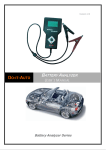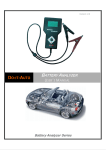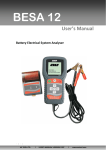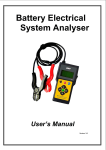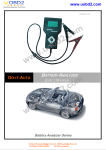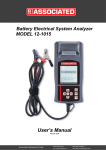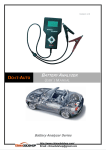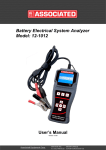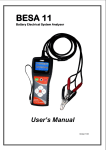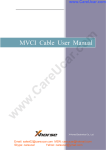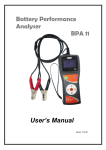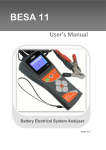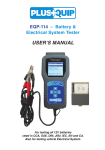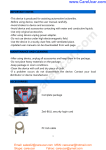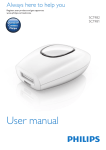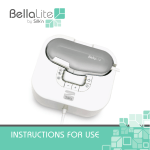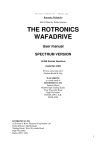Download SCAN-DIY CR-PRO User`s Manual
Transcript
www.CareUcar.com -1- Battery Analyzer User’s Manual w w w .C ar eU ca r.c om Version: 2.0 -1- Battery Analyzer Series Do-It-Auto Battery Analyzer Series Email: [email protected] MSN: [email protected] Skype: careucar Yahoo: [email protected] www.CareUcar.com Table of Contents 1.0 Introduction-----------------------------------------------------------------------------------------1.1 The Product-------------------------------------------------------------------------------------------------------3 1.2 Specifications----------------------------------------------------------------------------------------------------4 2.0 Safety Measures----------------------------------------------------------------------------------- om 3.0 2.1 Safety Precautions---------------------------------------------------------------------------------------------4 2.2 Other Precautions----------------------------------------------------------------------------------------------6 Working with Batteries--------------------------------------------------------------------------7 4.0 Types of Batteries--------------------------------------------------------------------------------9 5.0 The Analyzer---------------------------------------------------------------------------------------- 5.1 Main Unit---------------------------------------------------------------------------------------------------------11 5.2 Key Functions--------------------------------------------------------------------------------------------------12 5.2.1 Functions of Individual Key--------------------------------------------------------------------------------12 r.c 6.0 Battery Diagnosis---------------------------------------------------------------------------------- 6.1 Start Analyzing-------------------------------------------------------------------------------------------------13 7.0 False Capacity-----------------------------------------------------------------------------------21 ca 8.0 Ampere-Hour (AH) Rating--------------------------------------------------------------------22 9.0 State Of Charge (SOC) -------------------------------------------------------------------------9.1 Measuring the State Of Charge---------------------------------------------------------------------------22 9.2 Temperature Compensation-------------------------------------------------------------------------------24 10. Recharging Batteries ---------------------------------------------------------------------------- eU ar 11. 10.1 Bulk Charge-----------------------------------------------------------------------------------------------------25 10.2 Absorption Charge------------------------------------------------------------------------------------------- 26 10.3 Equalizing Charge --------------------------------------------------------------------------------------------26 10.4 Float Charge --------------------------------------------------------------------------------------------------- 26 10.5 Charging Voltage and Current ----------------------------------------------------------------------------27 Removal of Surface Charge------------------------------------------------------------------29 12. How to Revive a Sulfated Battery------------------------------------------------------------- .C 13. 12.1 Light Sulfation--------------------------------------------------------------------------------------------------30 12.2 Heavy Sulfation ----------------------------------------------------------------------------------------------- 31 Common Causes of Battery Failures -----------------------------------------------------31 14. Myth about Batteries---------------------------------------------------------------------------32 15. Battery Rating Charts----------------------------------------------------------------------------Japanese Industrial Standards (JIS#) Rating Chart----------------------------------------------- 34 DIN & EN Standards Rating Charts--------------------------------------------------------------------- 36 YUASA Battery Rating Chart------------------------------------------------------------------------------38 Rough CCA Guide-------------------------------------------------------------------------------------------- 38 w w 15.1 15.2 15.3 15.4 16. Alternator Test ------------------------------------------------------------------------------------- w 16.1 Start Testing----------------------------------------------------------------------------------------------------39 17. Cranking Test -------------------------------------------------------------------------------------17.1 Begin Testing---------------------------------------------------------------------------------------------------42 18. Notice------------------------------------------------------------------------------------------------18.1 Disclaimer-------------------------------------------------------------------------------------------------------43 19. Warranty Information----------------------------------------------------------------------------19.1 Limited Warranty----------------------------------------------------------------------------------------------44 19.2 Limitations of Warranty-------------------------------------------------------------------------------------45 Battery Analyzer Series Email: [email protected] MSN: [email protected] Skype: careucar Yahoo: [email protected] -2- www.CareUcar.com - 1.0 - Introduction ca r.c om 1.1-The Product: eU This Battery Analyzer is designed to test the condition of the automotive battery using conductance method. Unlike the conventional method of draining the battery by applying resistance load to it and obtain the result from the meter gauge; this analyzer utilizes a series of pulsed voltage across the battery cells and observes the AC current that flows in response to it. Conductance correlates directly to the battery capacity Passive testing method is safe. Never discharges or drain the battery. Able to test condition of discharged battery. Consistent and repeatable results. Provides unique indication of battery conditions. w .C • • • • • • ar The benefits of this test method are: w Besides, this analyzer also provides check the Alternator’s charging and Starter’s cranking conditions. w It is maintenance free and no internal batteries required. It powers up when connected to the battery posts during testing. -3- The operation is fast and simple. When hooked up to the battery posts, the displayed instructions on the screen will lead you through and a warning tone to caution you to perform the correct steps. Its result is consistent and repeatable and can be performed numerous times without heating up the unit. It is very safe as it does not create any sparks when connected to the battery terminals during testing on the vehicle. Battery Analyzer Series Email: [email protected] MSN: [email protected] Skype: careucar Yahoo: [email protected] www.CareUcar.com Operating Voltage: 9V ~ 15V (max) Analyzing Capacity (Amps): CCA EN IEC DIN JIS# Battery analyzing time: 100 ~ 1700 100 ~ 1000 100 ~ 1700 100 ~ 1000 (100 ~ 1700 CCA) Less than 5 seconds. r.c 2.0 Safety Measures: om 1.2 Specifications: ca For safety reasons, read this manual thoroughly before operating the Tool. eU Always refer to and follow the safety instructions and testing procedures provided by the car or equipment manufacturer. The safety messages presented below and throughout this user’s manual are reminders to the operator to exercise extreme care when using this test instrument. When the engine is running, it produces carbon monoxide, a toxic and poisonous gas. Always operate the vehicle in a well ventilated area. Do not breathe exhaust gases – they are hazardous that can lead to death. w w w .C ar 2.1 Safety Precautions: To protect your eyes from propellant object such as caustic liquids, always wear safety eye protection. Fuel and battery vapors are highly flammable. DO NOT SMOKE NEAR THE VEHICLE DURING TESTING. Battery Analyzer Series Email: [email protected] MSN: [email protected] Skype: careucar Yahoo: [email protected] -4- www.CareUcar.com - om When engine is running, many parts (such as pulleys, coolant fan, belts, etc) turn at high speed. To avoid serious injury, always be alert and keep a safe distance from these parts. r.c Before starting the engine for testing or trouble shooting, always make sure the parking brakes is firmly engaged. Put the transmission in Park (automatic transmission) and Neutral (manual transmission). ca Always block the drive wheels. Never leave vehicle unattended while testing. Engine parts become very hot when engine is running. To prevent severe burns, avoid contact with hot engine parts. Do not wear loose clothing or jewelry while working on engine. Loose clothing can get caught in fan, pulleys, belts, etc. Jewelry can conduct current and can cause severe burns if comes in contact between power source and ground. w w w .C ar eU Never lay tools on vehicle battery. You may short the terminals together causing harm to yourself, the tools or the battery. -5- When the engine is running, be cautious when working around the ignition coil, distributor cap, ignition wires and spark plugs. They are HIGH VOLTAGE components that can cause electrical Shock. Battery Analyzer Series Email: [email protected] MSN: [email protected] Skype: careucar Yahoo: [email protected] www.CareUcar.com - Always keep a fire extinguisher readily available and easily accessible in the workshop. om 2.2 Other Precautions: This battery analyzer is meant for testing of 12 Volts batteries only. • Its operating voltage is from 9V ~ 15V DC and should not be tested on 24V directly. It will cause damage the unit. For 12V x 2 batteries (in series or parallel), disconnect the connections and test them individually. • Battery that has just been charged by the charger contains surface charge and it should be discharged by turning ON the Head lights for 3~5 minutes before testing. • Always attached the analyzer clips on the lead side of the battery terminal posts during testing so that it has a good contact. This will provide better and accurate results. • Do not attach the analyzer clips directly onto the steel bolt that tightened to the battery terminal posts; this may give inaccurate readings or inconsistent results. (Note: This also applies to all other battery testing methods.) w .C ar eU ca r.c • If the battery terminal posts were oxidized or badly corroded and the connections were bad, the analyzer will prompt you to check the connections. In this case, clean the terminal posts and performs testing directly on the terminal posts it-self. w w • • During testing on the battery whist it is still in the car, make sure the engine is OFF. • Do not store the battery analyzer near high humidity or temperature area. Exposing to extreme temperatures will cause damage to the unit. Battery Analyzer Series Email: [email protected] MSN: [email protected] Skype: careucar Yahoo: [email protected] -6- www.CareUcar.com - 3.0 Working with Batteries Lead-acid batteries contain a sulfuric acid electrolyte, which is a highly corrosive poison and will produce gasses when recharged and explode if ignited. This will hurt you--BAD! om When working with batteries, you need to have plenty of ventilation, remove your jewelry, wear protective eyewear (safety glasses) and clothing, and exercise caution. Do not allow battery electrolyte to mix with salt water. Even small quantities of this combination will produce chorine gas that can KILL you! ar eU ca r.c Whenever possible, please follow the manufacturer's instructions for testing, jumping, installing, charging and equalizing batteries. .C ¾ Never disconnect a battery cable from a vehicle with the engine running because the battery acts like a filter for the electrical system. w w w Unfiltered [pulsating DC] electricity can damage expensive electronic components, e.g., emissions computer, radio, charging system, etc. -7- Turn off all electrical switches and components, turn off the ignition and then disconnect the battery. ¾ For non-sealed batteries, check the electrolyte level. Make sure it is covering the plates, and it is not frozen before starting to recharge. Battery Analyzer Series Email: [email protected] MSN: [email protected] Skype: careucar Yahoo: [email protected] www.CareUcar.com - ¾ Do not add distilled water if the electrolyte is covering the top of the plates because during the recharging process, it will warm and expand. After recharging has been completed, recheck the level. om ¾ Reinstall the vent caps BEFORE recharging, recharge ONLY in well-ventilated areas, and wear protective eye ware. Do NOT smoke or cause sparks or flames while the battery is being recharged because batteries give off explosive gasses. r.c ¾ If your battery is an AGM or a sealed flooded type, do NOT recharge with current ABOVE 12% of the battery's RC rating (or 20% of the ampere-hour rating). ca Gel cells should be charged over a 20-hour period and never over the manufacturer's recommended level or over 14.1 VDC. eU ¾ Follow the battery and charger manufacturer's procedures for connecting and disconnecting cables and other steps to minimize the possibility of an explosion or incorrectly charging the battery. ar You should turn the charger OFF before connecting or disconnecting cables to a battery. w w w .C Do not wiggle the cable clamps while the battery is recharging, because a spark might occur, and this could cause an explosion. Good ventilation or a fan is recommended to disperse the gasses created by the recharging process. ¾ If a battery becomes hot, over 110° F (43.3° C), or violent gassing or spewing of electrolyte occurs, turn the charger off temporarily or reduce the charging rate. ¾ Ensure that charging with the battery in the car with an external MANUAL charger will not damage the vehicle's electrical system with high voltages. If this is even a remote possibility, then disconnect the vehicle's battery cables from the battery BEFORE connecting the charger. Battery Analyzer Series Email: [email protected] MSN: [email protected] Skype: careucar Yahoo: [email protected] -8- www.CareUcar.com - 4.0 – Types of Batteries Basically the major types of batteries are as follows: • Starting Battery om Sometimes it is called SLI (Starting, Lighting and Ignition) battery and it is designed to start and run engines. It delivers quick bursts of energy (such as starting engines) and have a greater plate count. r.c The plates will also be thinner and are composed of a Lead "sponge", similar in appearance to a very fine foam sponge. This gives a very large surface area, but if deep cycled, this sponge will quickly be consumed and fall to the bottom of the cells. ca Automotive batteries will generally fail after 30-150 deep cycles if deep cycled, while they may last for thousands of cycles in normal starting use (2-5% discharge). Starting batteries are usually rated at "CCA", or cold cranking amps, or "MCA", Marine cranking amps - the same as "CA". Deep Cycle Battery eU • These batteries are used mainly on golf cart, scooter, solar, RV, etc has less instant energy but greater long-term energy delivery. .C ar They are designed to be discharged down as much as 80% time after time, and have much thicker plates. The major difference between a true deep cycle battery and others is that the plates are SOLID Lead plates - not sponge. w Deep cycle batteries are usually rated at “AH” or Amperes Hour. Marine Battery w w • -9- These batteries are usually actually a "hybrid", and fall between the starting and deep-cycle batteries. The plates may be composed of Lead sponge, but it is coarser and heavier than that used in starting batteries. "Hybrid" types should not be discharged more than 50%. Battery Analyzer Series Email: [email protected] MSN: [email protected] Skype: careucar Yahoo: [email protected] www.CareUcar.com - Major types of battery construction: • Wet Cell (Flooded) om Wet or Flooded cell batteries are divided into low maintenance (the most common) and maintenance free (or sealed), which is based on their plate formulation. • r.c Low maintenance batteries have lead-antimony/antimony or lead-antimony/calcium (dual alloy or hybrid) plates thus the maintenance free batteries use lead-calcium/calcium. AGM ca The Absorbed Glass Matt (AGM) are also sometimes called "starved electrolyte" or "dry", because its fiberglass mat is only 95% saturated with Sulfuric acid and there is no excess liquid. eU This construction allows the electrolyte to be suspended in close proximity with the plate’s active material. In theory, this enhances both the discharge and recharge efficiency. ar Nearly all AGM batteries are sealed valve regulated (commonly referred to as "VRLA" - Valve Regulated Lead-Acid). .C Most valves regulated are under some pressure - 1 to 4 psi at sea level. w Popular usages are high performance engine starting, power sports, deep cycle, solar and storage battery. GEL Cell w w • The Gel Cell is similar to the AGM style because the electrolyte is suspended, but it is different because technically the AGM battery is still considered to be a wet cell. The electrolyte in a GEL cell has a silica additive that causes it to set up or stiffen. All Gel Cell batteries are sealed and a few are "valve regulated", which means that a tiny valve keeps a slight positive pressure. Battery Analyzer Series Email: [email protected] MSN: [email protected] Skype: careucar Yahoo: [email protected] - 10 - www.CareUcar.com - The recharge voltages on this type of cell are lower than the other styles of lead acid battery. This is probably the most sensitive cell in terms of adverse reactions to over-voltage charging. If the incorrect battery charger is used on a Gel Cell battery, poor performance and premature failure is certain. om Gel Cell batteries are best used in VERY DEEP cycle application and may last a bit longer in hot weather applications. The Gel Cell and the AGM batteries are specialty batteries. They store very well and do not tend to sulfate or degrade as easily as Wet Cell. ca r.c Also, there is little chance of a hydrogen gas explosion or corrosion when using these batteries which made them the safest lead acid batteries. .C Keypad ar 5.1 - Main Unit eU 5.0 - The Battery Analyzer LCD Display Results and instructions Battery Terminal Clips w w w Command keys to access to various functions. - 11 - Figure 1 Battery Analyzer Series Email: [email protected] MSN: [email protected] Skype: careucar Yahoo: [email protected] www.CareUcar.com - 5.2 - Keypad Functions: 1 5 2 om 4 6 ca Figure 2 r.c 3 5.2.1 Functions of Individual key: Use this key to scroll up to the next item OR when it is in the keying-in Battery Ratings values mode, press this key once will increase the value by step of 5 units. 2. Use this key to shift the selection tab to the right item OR when it is in the keying-in Battery Ratings values mode, press this key once will increase the value by step of 100 units. w 3. .C ar eU 1. w w 4. Use this key to scroll down to the next item OR when it is in the keying-in Battery Ratings values mode, press this key once will decrease the value by step of 5 units. Use this key to shift the selection tab to the left item OR when it is in the keying-in Battery Ratings values mode, press this key once will decrease the value by step of 100 units. 5. Press this key will ENTER into the selected function. 6. To EXIT, press this key once will return back to the previous screen. Battery Analyzer Series Email: [email protected] MSN: [email protected] Skype: careucar Yahoo: [email protected] - 12 - www.CareUcar.com - 6.0 - Battery Diagnosis 6.1 – Start Analyzing Attach the clips onto the battery terminal posts and the battery analyzer will power up and lights up the LCD display screen as shown (Fig.3). ca r.c 1. om This battery analyzer can perform testing while the battery is still fixed on the vehicle. Please make sure the engine is OFF. It will run through a self-test and when completed it displays the Main Menu as shown: (Fig. 4) Figure 4 w w .C ar 2. eU Figure 3 w 3. - 13 - 6. Pressing key once will scroll down to the next item if there is a need to select it. As an example (Fig.4) the selected item was on “Battery” and it is being highlighted. Battery Analyzer Series Email: [email protected] MSN: [email protected] Skype: careucar Yahoo: [email protected] www.CareUcar.com - Press key will proceed to do the battery testing and if it has detected any surface voltage on the battery, it will start to clean and a message is shown (Fig. 5) below. om 7. If the surface voltage is too great for the Analyzer to handle, it will prompt you with the instructions as shown: (Fig.6) below ar eU ca 8. r.c Figure 5 Wait until the surface voltage cleaning had completed, the analyzer will key. advise as follows: (Fig.7) and then press w w w 9. .C Figure 6 - 14 - Figure 7 Battery Analyzer Series Email: [email protected] MSN: [email protected] Skype: careucar Yahoo: [email protected] www.CareUcar.com - If there is no surface voltage, then it will straight away enter into “Select Input” menu screen as shown in Fig. 8 om 4. Before selecting the ratings ‘CCA, EN, IEC, and DIN & JIS #’ from the menu, check the battery specification value. This value can be checked on the battery labels as some of the examples shown below: w w w .C ar eU ca 8. r.c Figure 8 - 15 - Battery Analyzer Series Email: [email protected] MSN: [email protected] Skype: careucar Yahoo: [email protected] www.CareUcar.com - om If it is selected under JIS # (Japanese Industrial Standard) then the display will prompt you as shown (Fig.9) below. Figure 9 ar eU ca r.c Refer to the battery model (example: 80D26L or NX110-5L) on the Cold Cranking Amps (CCA) Table list either at the back of the Analyzer or from this manual on page 35 (See example Fig.10 below.) .C Figure 10 key and the display will show: (Fig.11) below w w w Press - 16 - Figure 11 Battery Analyzer Series Email: [email protected] MSN: [email protected] Skype: careucar Yahoo: [email protected] www.CareUcar.com - Referring to the Table list (Fig.10) under 80D26L, check the battery type: WET, MF, Sealed MF or Closed MF (CMF) as each category has different CCA ratings. For instance, if the battery is a Sealed MF (CMF) then it is rated at 630 CCA. 10. WET MF CMF - Wet Cell Type Maintenance Free Type Closed or Sealed Maintenance Free om Note: To enter the value 630, press key will increase the original value r.c 9. of 500 (Fig.11) by step of 100 units to 600. Likewise use key to increase the last two digits (00) to 30 by step of 5 units for each pressing. Figure 12 Once the CCA rating of the battery is confirmed, press key will start the testing process. Refer to the display below (Fig. 13). w w w 11. .C ar eU ca (Fig. 12) - 17 - Figure 13 Battery Analyzer Series Email: [email protected] MSN: [email protected] Skype: careucar Yahoo: [email protected] www.CareUcar.com - For less than 5 seconds, the results of the testing will be displayed on the LCD screen. (Fig. 14) om 12. Interpretations of the above results: r.c Figure 14 RESULTS: Good A very straight forward display of the final results basing on the evaluation of the tested condition. ‘Good’ indicates the battery in good condition. ‘Replace’ indicates that the battery needs to be replaced. If not, the battery will fail anytime without any warning. 2. Voltage : 12.46V This indicates the tested battery voltage (12.46V). It depends on the state of charge on the battery: eU ca 1. - 13.20V 12.90V 12.45V .C ar 100% fully charged 90% charged 75% charged CCA (Cold Cranking Amps): 406 CCA CCA ratings has been used here, therefore the tested result is in 406 CCA. If other rating (DIN or JIS, or IEC, or EN) were selected, it will base on the respective rating to calculate and show the results in that selected rating. w w 3. w 4. 5. Int. R (Internal Resistance): 6.72mΩ In normal condition, the internal resistance should fall between 2.0 mΩ ~ 15.0 mΩ. As a matter of fact, the higher the battery CCA readings obtained the lower the internal resistance should be. LIFE: 50 % This is an indication of the battery life expectancy in percentage. If the life falls below 45 %, the RESULT will display “Replace” and it is time to change to a new battery. Battery Analyzer Series Email: [email protected] MSN: [email protected] Skype: careucar Yahoo: [email protected] - 18 - www.CareUcar.com - Explanation of the following terms used as shown on the LCD display: CCA (Cold Cranking Amps) – most commonly used Standard. CCA is a rating used in the battery industry to rate a battery’s ability to start an engine in cold temperatures. This rating is the number of amperes that a new fully charged battery can delivery at 0°F (-18°C) for 30 seconds, while maintaining a voltage of at least 7.2 Volts for a 12V battery. om • The bigger the CCA will have the greater starting power of the battery. IEC (International Electrotechnical Commission) Standard. IEC amperes rating require that at 0°F (-18°C), the number of amperes that the 12V battery can deliver while maintaining a voltage of at least of 8.4 Volts for 60 seconds during cranking. • EN (European Norms) Standard EN amperes rating require that at 0°F (-18°C), the number of ampere that the 12V battery can deliver while maintaining a voltage of at least 6.0 Volts for 180 seconds during cranking. • JIS# (Japanese Industrial Standard) JIS # amperes’ rating is based on Ampere Hours and is calculated using 20 hours rating. In this manual, it is using CCA ratings reference table list provided basing on the JIS model number (See page 34). • DIN (Deutsches Institut für Normung) - German Institute for Standardization. Taking an example: DIN 100 Amperes Basing on DIN 100 Amp battery, the rating requires that at 0°F (-18°C), the battery is able to deliver 100 amperes while maintaining a voltage of at least of 9.0 Volts for 30 seconds and 8.0 Volts for 150 seconds during cranking. Unknown If you are not sure which ratings (CCA, EN, IEC, JIS or DIN) that the battery is based on then choose this setting. It will show the battery’s Voltage, CCA and the Internal Resistance (mΩ) only. This selection can also be used to test 12V - Deep Cycle Batteries. w w • .C ar eU ca r.c • w An example of the results display is shown below: - 19 - Figure 15 Battery Analyzer Series Email: [email protected] MSN: [email protected] Skype: careucar Yahoo: [email protected] www.CareUcar.com - Use Voltage (should not fall below 12.6V when fully charged) and the Internal Resistance [Int.R] (should not more 15mΩ) readings to determine the condition of the tested Deep Cycle Battery. r.c om Batteries that had been left idle for long periods can still be tested with this analyzer. To perform the test, just clamp the analyzer clips onto the battery terminals and it will display the screen (Fig.16) as shown if its voltage falls below the normal 12 volts and a buzzing sound is heard. ca Figure 16 key to continue and the display will show: (Fig.17) Figure 17 w .C ar eU Press w w Check the battery ratings and enter it as described in step 10 (page 13) and the results will show as an example below: - 20 - Figure 18 Battery Analyzer Series Email: [email protected] MSN: [email protected] Skype: careucar Yahoo: [email protected] www.CareUcar.com - You will notice that there is no indication of message (Good or Replace) on the RESULTS instead on LIFE; it indicates “Charge Retest”. Recharge the battery fully and repeat the test again. 13. Pressing the key at any moment will exit and return back to the previous screen. om 7.0 – False Capacity r.c A battery can meet all the tests for being at full charge, yet be much lower than its original capacity. If plates are damaged, sulfated, or partially gone from long use, the battery may give the appearance of being fully charged, but in reality acts like a battery of much smaller size. ca This same thing can occur in GEL Cells if they are overcharged and gaps or bubbles occur in the gel. What is left of the plates may be fully functional, but with only 20% of the plates left... eU Batteries usually go bad for other reasons before reaching this point, but it is something to be aware of if your batteries seem to test OK but lack capacity and go dead very quickly under load. ar 8.0 – Amperes-Hour (AH) Rating .C All Deep Cycle batteries are rated in amp-hours (AH). An amp-hour is one amp for one hour, or 10 amps for 1/10 of an hour and so forth. It is Amps multiply (x) by Hours. w w For example, if you have something that draws 20 amps, and you use it for 20 minutes, then the amp-hours used would be 20 (amps) x .333 (hours), or 6.67 AH. w The ‘20 Hour Rate’ is the accepted AH rating time period for batteries used in solar electric and backup power systems (and also for nearly all Deep Cycle batteries). - 21 - This means that it is discharged down to 10.5 volts over a 20 hour period while the total actual amp-hours that it supplies are measured. Sometimes ratings at the 6 hour rate and 100 hour rate are also given for comparison and for different applications. The 6 hour rate is often used for industrial batteries, as that is a typical daily duty cycle. Sometimes the 100 hour rate is given just to make the battery look Battery Analyzer Series Email: [email protected] MSN: [email protected] Skype: careucar Yahoo: [email protected] www.CareUcar.com - better than it really is, but it is also useful for figuring battery capacity for long-term backup Amperes-Hour (AH) requirements. Amperes-Hour (AH) is specified at a particular rate because of something called the Peukert Effect. The Peukert value is directly related to the internal resistance of the battery. The higher the internal resistance, the higher the losses while charging and discharging, especially at higher currents. om This means that the faster a battery is used (discharged), the LOWER the AH capacity. Conversely, if it is drained slower, the AH capacity is higher. r.c 9.0 – State Of Charge (SOC) ca State of charge (SOC), or conversely, the depth of discharge (DOD) can be determined by measuring the voltage and/or the specific gravity of the acid with a hydrometer. This will NOT tell you how good (capacity in AH) the battery condition is - only a sustained Load Test can do that. eU Voltage on a fully charged battery will read 2.12 to 2.15 volts per cell, or 12.7 volts for a 12 volt battery. At 50% the reading will be 2.03 VPC (Volts Per Cell), and at 0% will be 1.75 VPC or less. ar Specific gravity will be about 1.265 for a fully charged cell, and 1.13 or less for a totally discharged cell. .C Many batteries are sealed, and hydrometer reading cannot be taken, so you must rely on voltage measurement. Hydrometer readings may not tell the whole story, as it takes a while for the acid to get mixed up in wet cells. w w If measured right after charging, you might see 1.27 at the top of the cell, even though it is much less at the bottom. This does not apply to gelled or AGM batteries. w 9.1 Measuring the State Of Charge (SOC) If the battery's electrolyte is above 110° F (43.3° C), allow it to cool down. To determine the battery's state-of-charge with the battery's electrolyte temperature at 80° F (26.7° C), use the following table below. The table assumes that a 1.265 specific gravity reading is for a fully charged, Wet Cell, Lead Acid battery. Battery Analyzer Series Email: [email protected] MSN: [email protected] Skype: careucar Yahoo: [email protected] - 22 - www.CareUcar.com - For other electrolyte temperatures, use the Temperature Compensation table below to adjust the Open Circuit Voltage or Specific Gravity readings. The Open Circuit Voltage will vary for GEL Cell and AGM type batteries, so check the manufacturer's specifications. 100% Hydrometer Average Cell Specific Gravity 1.265 12.45 V 75% 1.225 12.24 V 50% 1.190 12.06 V 25% 1.155 11.89 V Discharged 1.120 Electrolyte Freeze Point om Approximate State-of-Charge -75° F (-59.4° C) -55° F (-48.3° C) -34° F (-36.7° C) -16° F (-26.7° C) -10° F (-23.3° C) ca r.c Digital Voltmeter Open Circuit Voltage 12.65 V eU STATE-OF-CHARGE [Source: BCI] Electrolyte Temperature Celsius (°C) 160° 150° 140° 130° 120° 110° 100° 90° 80° 70° 60° 50° 40° 30° 20° 10° 0° 71.1° 65.6° 60.0° 54.4° 48.9° 43.3° 37.8° 32.2° 26.7° 21.1° 15.6° 10° 4.4° -1.1° -6.7° -12.2° -17.8° w w w .C ar Electrolyte Temperature Fahrenheit (°F) - 23 - Add or Subtract to Hydrometer's SG Reading +.032 +.028 +.024 +.020 +.016 +.012 +.008 +.004 0 -.004 -.008 -.012 -.016 -.020 -.024 -.028 -.032 Add or Subtract to Digital Voltmeter's Reading +.192 V +.168 V +.144 V +.120 V +.096 V +.072 V +.048 V +.024 V 0V -.024 V -.048 V -.072 V -.096 V -.120 V -.144 V -.168 V -.192 V Battery Analyzer Series Email: [email protected] MSN: [email protected] Skype: careucar Yahoo: [email protected] www.CareUcar.com - 9.2 Temperature Compensation Electrolyte temperature compensation is depending on the battery manufacturer's recommendations and will vary. When using a non-temperature compensated HYDROMETER, make the adjustments referring to the table above. om For example: At 30° F (-1.1° C), the specific gravity reading would be (1.265 – 0.020) 1.245 for a 100% State-of-Charge. r.c At 100° F (37.8° C), the specific gravity would be (1.265 + 0.008) 1.273 for 100% State-of- Charge. This is why using a temperature compensated hydrometer is highly recommended and more accurate than other means. ca If you are using a DIGITAL VOLTMETER, make the adjustments indicated in the table above. For example: eU At 30° F (-1.1° C), the voltage would be (12.65 – 0.120) 12.53 V for a 100% State-of-Charge. ar At 100° F (37.8° C), the voltage would be (12.65 + 0.048) 12.698 V for 100% State-of-Charge. .C For non-sealed batteries, check the specific gravity in each cell with a hydrometer and average the readings. w For sealed batteries, measure the Open Circuit Voltage across the battery terminals with an accurate digital voltmeter. This is the only way you can determine the State-of-Charge (SOC). w Some batteries have a built-in hydrometer, which only measures the State-of-Charge in one of its six cells. w If the built-in indicator is clear or light yellow, then the battery has a low electrolyte level and should be refilled and recharged before proceeding. If sealed, the battery is toast and should be replaced. If the State-of-Charge is below 75% using either the specific gravity or voltage test or the built-in hydrometer indicates bad (usually dark), then the battery needs to be recharged before proceeding. Battery Analyzer Series Email: [email protected] MSN: [email protected] Skype: careucar Yahoo: [email protected] - 24 - www.CareUcar.com - You should replace the battery, if one or more of the following conditions occur: If there is a .05 (sometimes expressed as 50 points) or more difference in the specific gravity reading between the highest and lowest cell, you have a weak or dead cell(s). If you are really lucky, applying an EQUALIZING charge may correct this condition. (See Equalizing Charge – page 26) • If the battery will not recharge to a 75% or more state-of-charge level or if the built-in hydrometer (LED display) still does not indicate green (which is 65% state-of-charge or better). • If digital voltmeter result indicates 0 volts, you have an open cell. • If the digital voltmeter or the battery analyzer’s results indicates 10.45 to 10.65 volts, you probably have a shorted cell or a severely discharged battery. A shorted cell is caused by plates touching, sediment (mud) build-up or treeing between the plates. ca r.c om • eU If you know that a battery has spilled or bubbled over and the electrolyte has been replaced with water, you can replace the old electrolyte with new electrolyte and recharge again. Battery electrolyte is a mixture of 25% sulfuric acid and distilled water. ar 10.0 – Recharging Batteries w w w .C Battery charging takes place in the following 4-basic stages: - 25 - 10.1 • Bulk • Absorption • Equalizing • Float Bulk Charge (1st Stage) Current is sent to batteries at the maximum safe rate which is accepted until voltage rises to near (80-90%) full charge level. Voltages at this stage typically range from 10.5 volts to 15 volts. There is no "correct" voltage for bulk charging, but there may be limits on the maximum current that the battery and/or wiring can take. Battery Analyzer Series Email: [email protected] MSN: [email protected] Skype: careucar Yahoo: [email protected] www.CareUcar.com - 10.2 Absorption Charge (2nd Stage) Voltage remains constant and current gradually tapers off as internal resistance increases during charging. It is during this stage that the charger puts out maximum voltage. Voltages at this stage are typically around 14.2 to 15.5 volts. Equalizing Charge (3rd Stage) om 10.3 This optional equalizing phase is a controlled 5% overcharge, which equalizes and balances the voltage and specific gravity in each cell, the effect of increasing the charge voltage. r.c Equalizing reverses the build-up of chemical effects like stratification, where acid concentration is greater at the bottom of the battery. It also helps to remove sulfate crystals that might have built up on the plates. ca The frequency recommendation varies by manufacturer from once a month to once a year, from 10 to 100 deep cycles, or when a specific gravity difference between cells reaches .03 (or 30 points). eU To equalize a battery, fully recharge it; next, increase the charging voltage to the manufacturer's recommendations (if you cannot find one, add 5%). Heavy gassing should start occurring at this stage (be very careful about safety precautions). 10.4 .C ar Take specific gravity readings in each cell once every hour. Equalization has occurred once the specific gravity values no longer rise during the gassing stage. Float Charge (4th Stage) w w w After batteries reach full charge, charging voltage is reduced to a lower level (typically 12.8 to 13.2) to reduce gassing and prolong battery life. This is often referred to as a maintenance or trickle charge, since its main purpose is to keep an already charged battery from discharging. Charger with PWM, or "pulse width modulation" accomplishes the same thing. In PWM, the controller or charger senses tiny voltage drops in the battery and sends very short charging cycles (pulses) to the battery. - 26 - This may occur several hundred times per minute. It is called "pulse width" because the width of the pulses may vary from a few microseconds to several seconds. NOTE: For long term float charging, such as backup power systems that are seldom discharged, the float voltage should be set around 13.02 to 13.20 volts. Battery Analyzer Series Email: [email protected] MSN: [email protected] Skype: careucar Yahoo: [email protected] www.CareUcar.com - 10.5 Charging Voltage and Current Most garage and consumer (automotive) type battery chargers are bulk charge only, and have little (if any) voltage regulation. They are fine for a quick boost to low batteries, but do not to leave them on charging for long periods. om Use an external Constant Current charger, which is set not to deliver more than 12% of the Reserve Capacity (RC) rating of the battery and monitor the State-Of-Charge (SOC). Timers that will cut-off the charger when charging hours are completed will help prevent overcharging of the battery. NOTE: r.c Reserve Capacity (RC) is the number of minutes a fully charged battery at 80° F (26.7° C) is discharged at 25 amps before the voltage falls below 10.5 volts. To convert Reserve Capacity (RC) to Ampere-Hours (AH) at the 25 amps rate, multiple RC by .4167. Slow Charge (RECOMMENDED) Fast Charge 15 Hours @ 3 Amps 5 Hours @ 10 Amps 21 Hours @ 4 Amps 7.5 Hours @ 10 Amps 22 Hours @ 5 Amps 10 Hours @ 10 Amps 23 Hours @ 6 Amps 7.5 Hours @ 20 Amps 24 Hours @ 10 Amps 6 Hours @ 40 Amps w .C ar eU Reserve Capacity (RC) Rating 80 Minutes or less [32 Ampere-Hours or less] 80 to 125 Minutes [32 to 50 Ampere-Hours] 125 to 170 Minutes [50 to 68 Ampere-Hours] 170 to 250 Minutes [68 to 100 Ampere-Hours] Above 250 Minutes [over 100 Ampere-Hours] ca For discharged batteries, the following table lists the recommended battery charging rates and times: The best method is to slowly recharge the battery at 70° F (21.1° C) over a 10 to w w 20 hour period (C/10 to C/20)*using an external constant voltage (or tapered current charger) because the acid has more time to penetrate the plates and there is less mechanical stress on the plates. *NOTE: - 27 - C-rate is a measurement of the charge or discharge of battery overtime. It is expressed as the Capacity of the battery divided by the number of hours to recharge or discharge the battery. For example, assume that the Amperes-Hour capacity of the battery is 220 AH, then it would take 11 hours (220 divided by 20) to recharge or discharge the battery using a C/20 rate. Battery Analyzer Series Email: [email protected] MSN: [email protected] Skype: careucar Yahoo: [email protected] www.CareUcar.com - For a Constant Voltage charger, apply regulated voltage at approximately 13.8 to 16 volts and should be based on the manufacturer's recommendations and temperature. A 10 Amps Constant Voltage charger is suitable for most simple recharging or charging applications. om More expensive three-stage microprocessor controlled chargers are also available that will automatically provide bulk, absorption and float charging. A four-stage charger will provide an equalizing charge in addition to the bulk, absorption and float charging. Float Voltage 13.2 13.4 Equalizing Voltage 15.1 15.5 14.4 14.4 14.1 14.5 13.2 13.6 13.2 13.2 15.1 15.5 N/A 15.8 NOTE: ar eU Wet Low Maintenance Wet Maintenance Free Sealed &VRLA AGM Gel Cell Wet Deep Cycle Charging Voltage 14.4 14.8 ca Battery Type r.c An excellent automatic Constant Voltage battery charger is a 15-volt regulated power supply adjusted to the manufacturer’s recommendations or, if not available, refers to voltage ranges below which were based on the electrolyte temperature at 70° F (21.1° C). .C To compensate for electrolyte temperature, which has a negative temperature compensation coefficient, adjust the charging voltage .0028 (2.8 millivolts) to .0033 (3.3 millivolts) volts per cell per degree F. w w w For example, if the temperature is 30° F (-1.1° C), then increase the charging voltage to 15.19 volts for a wet low maintenance battery. If 100° F (43.3° C), then decrease the charging voltage to 13.81 volts. If left unattended, cheap, unregulated trickle or manual battery chargers can overcharge your battery because they can decompose the water out of the electrolyte. Avoid using fast, high rate, or boost chargers on any battery that is sulfated or deeply discharged. The electrolyte should NEVER bubble violently while recharging because high currents only create heat and excess explosive gasses. Battery Analyzer Series Email: [email protected] MSN: [email protected] Skype: careucar Yahoo: [email protected] - 28 - www.CareUcar.com - Most flooded (Wet Cell) batteries should be charged at no more than the "C/8" rate for any sustained period. Note: “C/8" is the battery capacity at the 20-hour rate divided by 8. For a 220 AH battery, this would equal 26 Amps. om GEL Cells batteries should be charged at no more than the C/20 rate, or 5% of their AH capacity. Charging at 15.5 volts will give you a 100% charge on Lead-Acid batteries. Once the charging voltage reaches 2.583 volts per cell, charging should stop or be reduced to a trickle charge. Note: r.c Flooded or Wet Cell batteries MUST bubble (gas) somewhat to insure a full charge, and to mix the electrolyte. ca Float voltage for Lead-Acid batteries should be about 2.15 to 2.23 volts per cell, or about 12.9 to 13.4 volts for a 12 volt battery. At higher temperatures (over 85 degrees F) this should be reduced to about 2.10 volts per cell. eU NEVER ADD ACID to a battery except to replace spilled liquid. Distilled or de-ionized water should be used to top off non-sealed batteries. Float and charging voltages for GEL Cell batteries are usually about 2/10th volt less than for flooded to reduce water loss. ar Flooded or Wet Cell battery life can be extended if an equalizing charge is applied every 10 to 40 days. This is a charge that is about 10% higher than normal full charge voltage, and is applied for about 2 to 16 hours. w .C This makes sure that all the cells are equally charged, and the gas bubbles mix the electrolyte. If the liquid in standard wet cells is not mixed, the electrolyte becomes "stratified". You can have very strong solution at the top and very weak at the bottom of the cell. w With stratification, you can test a battery with a hydrometer and get readings that are quite a ways off. If you cannot equalize for some reason, you should let the battery sit for at least 24 hours and then use the hydrometer. w AGM and GEL Cell should be equalized 2-4 times a year at most. Please check the manufacturer’s recommendations, especially on GEL Cell ones. - 29 - Battery Analyzer Series Email: [email protected] MSN: [email protected] Skype: careucar Yahoo: [email protected] www.CareUcar.com Battery Ana User’s Manual - 11.0 – Removal of Surface Charge Surface charge is the uneven mixture of sulfuric acid and water within the surface of the plates as a result of charging or discharging. It will make a weak battery appear good or a good battery appears bad. om To eliminate the surface charge, use one of the following methods: ¾ Allow the battery to sit for four to twelve hours to allow for the surface charge to dissipate. r.c ¾ Apply a load that is 33% of the Ampere-Hour (AH) capacity for five minutes and wait five to ten minutes. ca ¾ With a battery load tester, apply a load of at least one half the battery's CCA rating for 15 seconds and wait five to ten minutes. eU 12.0 – How to Revive a Sulfated Battery? ar Lead sulfation occurs when a lead sulfate compound is deposited on the lead electrodes of a storage battery; this is a problem if the lead sulfate compound cannot be converted back into charged material and is created when discharged batteries stand for a long time. w .C When the state-of-charge (SOC) drops below 80%, the plates become coated with a hard and dense layer of lead sulfate, which fill up the pores. The positive plates will be light brown and the negative plates will be dull off-white. Over time, the battery loses capacity and cannot be recharged. w 12.1 Light Sulfation w Apply a constant current from one to two amps for 48 to 120 hours at 14.4 VDC, depending on the electrolyte temperature and capacity of the battery. Cycle (discharge to 50% and recharge) the battery a couple of times and test capacity. You might have to increase the voltage in order to break down the hard lead sulfate crystals. If the battery gets above 110° F (43.3° C) then stop charging and allow the battery to cool down before continuing. Battery Analyzer Series Email: [email protected] MSN: [email protected] Skype: careucar Yahoo: [email protected] - 30 - www.CareUcar.com - 12.2. Heavy Sulfation Replace the electrolyte with distilled water, let stand for one hour, apply a constant current of four amps at 13.8 VDC until there is no additional rise in specific gravity. om Remove the old electrolyte, wash the sediment out, replace with fresh electrolyte, and recharge. If the specific gravity exceeds 1.300, then remove the old electrolyte, wash the sediment out, and start over with distilled water. If the battery electrolyte rises above 110° F (43.3° C), then stop charging and allow the battery to cool down before continuing. Cycle (discharge to 50% and recharge) the battery a couple of times and test capacity. ca r.c The sulfate crystals are more soluble in distilled water than in electrolyte. As they are dissolved, the sulfate is converted back into sulfuric acid and the specific gravity rises. These techniques will only work with some batteries. 13.0 – Common Causes of Battery Failures eU The most common causes of premature battery failures are: 1. Loss of electrolyte due to heat or overcharging. ar 2. Lead sulfation in storage. 3. Undercharging. .C 4. Old age (positive plate shedding) 5. Excessive vibration. w 6. Freezing or high temperatures. w w 7. Using tap water which causes calcium sulfation. 8. Positive grid corrosion or growth due to high temperatures. 9. Fast recharging at rates greater than C/10. - 31 - Battery Analyzer Series Email: [email protected] MSN: [email protected] Skype: careucar Yahoo: [email protected] www.CareUcar.com - 14.0 – Myth about Batteries 1. Driving a car will fully recharge a battery? om Some of factors affecting a car charging system's ability to charge a battery are: how much current from the alternator is diverted to the battery to charge it, how long the current is available and the temperature. Generally, idling the engine or on short stop-and-go trips during bad or hot weather or at night will not recharge a battery. A long daytime trip in warm weather should recharge a battery. r.c 2. Testing of the alternator by disconnecting the battery while the engine is running. ca A battery acts like a voltage stabilizer or filter to the pulsating DC produced by the charging system. eU Disconnecting a battery while the engine is running can destroy sensitive electronic components, for example, emission computer, audio system, cell phone, alarm system, etc., or even the charging system itself. These damages can occur because the voltage can rise to 40 volts or more. ar In the 1970s, removing a battery terminal was an accepted practice to test charging systems of that era. That is not the case today. Just say NO if anyone suggests this. .C 3. Maintenance Free (MF) batteries never require maintenance? w In hot climates, water in the electrolyte is decomposed due to the high temperatures and normal charging of a wet maintenance free battery. Water can also be lost due to excessive charging voltage or charging currents. w Non-sealed batteries are recommended in hot climates so they can be refilled with distilled water when this occurs. w 4. A battery will not lose its charge while kept in storage. Depending on the type of battery, it has natural self-discharge or internal electrochemical leakage at a 1% to 15% rate per month that will cause it to become sulfated and fully discharged over time. Higher temperatures accelerate this process. A battery stored at 95° F (35° C) will self discharge twice as fast than one at 75° F (23.9° C). Battery Analyzer Series Email: [email protected] MSN: [email protected] Skype: careucar Yahoo: [email protected] - 32 - www.CareUcar.com - 5. A battery will not explode. Recharging a wet lead-acid battery normally produces hydrogen and oxygen gasses. While spark retarding vent caps help prevent battery explosions, they do occur when jumping, connecting or disconnecting charger or battery cables, and starting the engine. While not fatal, battery explosions cause thousands of eye and burn injuries each year. om When battery explosions occur when starting an engine, here is the usual sequence of events: r.c o One or more cells had a high concentration of hydrogen gas (above 4.1%) because the vent cap was clogged or a defective valve did not release the gas. o The electrolyte levels fell below the top of the plates due to high under hood temperatures, overcharging, or poor maintenance. ca o A low resistive bridge or treeing formed between the top of the plates such that when the current started to flow, it caused an arc or spark in one of the cells. eU That combination of events ignites the gas, blows the battery case cover off and spatters electrolyte all over the engine compartment. The largest number of battery explosions while starting an engine occurs in hot climates. ar When an explosion happens, thoroughly rinse the engine compartment with water, and then wash it with a solution of one-pound baking soda to one gallon of warm water to neutralize the residual battery acid. Then thoroughly rewash the engine compartment with water. .C Working on well ventilated areas or using Valve Regulated Lead Acid (AGM or gel cell) type batteries can significantly reduce the possibility of battery explosions. w 6. Batteries last longer in hot climates than in cold ones. w w Not really, in hot climates batteries only last approximately two thirds as long compared to cold ones. Heat kills batteries, especially sealed wet lead acid batteries. - 33 - 7. Pulse chargers, aspirins or additives will revive sulfated batteries. Using pulse chargers or additives is a very controversial subject. Most battery experts agree that there is no conclusive proof that more expensive pulse charges work any better than constant voltage chargers to remove sulfation. They also agree that there is no evidence that additives or even aspirins provide any long-term benefits. o-It-Auto Battery Analyzer Series Email: [email protected] MSN: [email protected] Skype: careucar Yahoo: [email protected] www.CareUcar.com - 8. Deep cycle batteries have a memory effect. Lead acid deep cycle batteries do not have the so called memory effect that first generation Ni-Cad batteries have. 9. On really cold days turn your headlights on to warm up the battery up before starting your engine. om While there is no doubt that turning on your headlights will increase the current flow in a car battery; it also consumes valuable capacity that could be used to start the engine. Therefore, this is not recommended. For extremely cold temperatures, externally powered battery warmers, battery blankets, or engine block heaters are highly recommended. ca r.c AGM and Ni-Cad batteries perform better in extremely cold temperatures than wet cell batteries. 15.0 – Battery Ratings Charts OLD WET 200 200 200 200 250 250 270 270 200 200 245 245 245 245 270 270 240 240 280 280 270 270 270 270 .C NEW 26A17R 26A17L 26A19R 26A19L 28A19R 28A19L 32A19R 32A19L 26A17R 26B17L 28B17R 28B17L 28B19R 28B19L 32B20R 32B20L 32C24R 32C24L 34B17R 34B17L 34B19R 34B19L 34B19RS 34B19LS CCA ar Battery Model (JIS#) eU 15.1 Japanese Industrial Standard (JIS#) Ratings w w w 12N24-4 12N24-3 NT50-N24 NT50-N24L NX60-N24 NX60-N24L NS40S NS40LS NS40 NS40L N40 N40L NS40ZA NS40ZAL NS40ZAS NS40ZALS MF CMF SMF 220 220 264 264 295 295 325 325 400 400 325 325 325 325 400 400 400 400 Battery Model (JIS#) NEW 36B20R 36B20L 36B20RS 36B20LS 38B20R 38B20RS 38B20L 38B20LS 40B20L 40B20R 42B20R 42B20L 42B20RS 42B20LS 46B24R 46B24L 46B24RS 46B24LS 46B26R 46B26L 46B26RS 46B26LS 48D26R 48D26L OLD NS40Z NS40ZL NS40ZS NS40ZLS NX60-N24 NT60-N24S NX60-24L NX60-24LS NS60 NS60L NS60S NS60LS N50 N50L CCA WET 275 275 275 275 330 330 330 330 330 330 330 330 330 330 325 325 325 325 360 360 360 360 280 280 MF 300 300 300 300 340 340 340 340 CMF SMF 360 360 360 360 410 410 410 410 360 360 360 360 420 420 420 420 360 360 420 420 Battery Analyzer Series Email: [email protected] MSN: [email protected] Skype: careucar Yahoo: [email protected] - 34 - www.CareUcar.com - NX100-S6 NX100-S6L NT80-S6S NT80-S6LS N50Z N50ZL 355 355 435 435 430 430 350 350 520 520 420 420 415 415 390 390 490 490 500 500 500 490 490 450 450 580 580 580 370 370 480 480 420 420 420 420 440 440 500 500 500 500 500 500 525 525 540 540 520 520 520 520 540 540 520 520 520 580 580 625 625 630 630 580 580 580 580 580 540 540 735 725 580 630 NEW 80D26L 85B60K 85BR60K 95D31R 95D31L 95E41R 95E41L 105E41R 105E41L 105F51R 105F51 115E41R 115E41L 115F51R 115F51L 130E41R 130E41L 130F51R 130F51L 145F51R 145F51L 145G51R 150F51R 150F51L 165G51R 165G51L 170F51R 170F51L 180G51R 180G51L 195G51R 195G51L 190H52R 190H52L 245H52R 245H52L ar eU NS70 NS70L N70 N70L 35-60 25-60 310 310 500 500 390 390 MF 380 380 F100-5 F100-5L N70Z N70ZL NX120-7 NX120-7L N100 N100L N100Z N100ZL N100Z N100ZL NS120 NS120L N120 N120L NX200-10 NX200-10L WET 580 620 620 515 515 580 580 580 580 650 650 650 650 800 800 800 800 780 780 780 640 640 935 935 1045 1045 1090 1090 1145 1145 925 925 1530 1530 660 660 640 640 720 720 CMF SMF 630 500 500 850 850 770 770 880 880 800 800 800 800 960 960 960 960 920 920 900 1100 MF 580 NS150 NS150L N150 NT200-12 NT200-12L NS200 NS200L NX250-12 NX250-12L NT250-15 NT250-15L NX300-51 NX300-51L N200 N200L NX400-20 NX400-20L 980 980 1100 1100 1250 1250 w w w NX110-5 OLD NX110-5L CCA om 85BR60K 85B60K NT80-S6 NT80-S6L 50D20R 50D20L WET Battery Model (JIS#) CMF SMF 480 480 r.c OLD .C NEW 50D20R 50D20L 50D23R 50D23L 50D24R 50B24L 50D26R 50D26L 55D23R 55D23L 55B24R 55B24L 55B24RS 55B24LS 55D26R 55D26L 60D23R 60D23L 65D23R 65D23L 65D26R 65D26R 65D31R 65D31L 70D23R 70D23L 70D23R 75D23R 75D23L 75D26R 75D26L 75D31R 75D31L 80D23R 80D23L 80D26R CCA ca Battery Model (JIS#) - 35 - Battery Analyzer Series Email: [email protected] MSN: [email protected] Skype: careucar Yahoo: [email protected] 1300 1300 www.CareUcar.com - 15.2 DIN & EN Standards Rating Chart Battery Model No. Standards DIN EN Battery Model No. Standards DIN EN 52805 52815 53517 53520 53521 53522 53621 53624 53625 53638 53646 53653 53836 53890 54038 54039 54232 54312 54313 54317 54324 54434 54437 54449 54459 54459L 54464 54465 54466 54469 54519 54523 54524 54533 54537 54545 54551 54577 54578 54579 54580 54584 54590 54612 54801 54827 55040 55041 55042 55044 55046 55048 55056 180 180 175 150 150 150 175 175 175 175 175 175 175 175 175 175 175 210 220 210 220 210 210 210 210 210 220 210 210 210 210 220 220 210 190 190 220 220 220 220 220 220 210 210 190 240 265 220 220 265 300 300 320 55057 55068 55069 55218 55414 55415 55421 55422 55423 55427 55428 55457 55529 55530 55531 55545 55548 55552 55559 55559L 55563 55564 55565 55565L 55566 55567 55811 56012 56048 56049 56068 56069 56073 56077 56091 56092 56111 56216 56218 56219 56220 56225 56311 56312 56318 56322 56323 56420 56530 56618 56619 56620 56633 320 220 220 255 265 265 265 265 300 300 300 265 220 255 255 255 255 255 255 255 255 255 255 255 265 255 360 230 250 250 250 250 250 300 360 300 300 300 300 300 280 300 300 300 300 300 300 300 300 300 300 300 300 om 540 390 390 420 450 450 450 450 510 510 510 450 360 420 420 420 420 420 420 420 420 420 420 420 450 420 540 420 390 390 390 390 390 510 540 510 540 510 510 510 510 510 510 510 510 510 510 510 510 510 510 510 510 r.c ca eU ar .C w w w 240 240 300 240 240 240 300 300 300 300 300 300 300 300 300 300 300 360 330 360 330 360 360 360 360 360 330 360 360 360 360 300 300 360 300 300 300 300 300 300 300 300 330 360 300 360 450 360 360 450 510 540 540 Battery Analyzer Series Email: [email protected] MSN: [email protected] Skype: careucar Yahoo: [email protected] - 36 - www.CareUcar.com - Battery Model No. Standards DIN EN Battery Model No. Standards DIN EN 56638 56641 55647 56821 56820 56828 57024 57029 57113 57114 57217 57218 57219 57220 57230 57412 57412L 57413 57512 57513 57531 58424 58513 58514 58515 58521 58522 58527 58811 58815 58820 58821 58827 58833 58838 59017 59018 59040 59215 59218 59219 59226 59514 59518 59519 59615 59616 60018 60019 300 300 300 315 315 315 315 315 400 400 420 420 420 420 380 400 400 400 350 350 350 450 320 320 450 320 320 395 440 395 395 395 400 400 400 360 360 360 450 290 290 450 320 395 395 360 360 250 250 60026 60038 60044 60527 60528 61017 61018 61023 61047 61048 62034 62038 62045 62529 63013 63545 63549 64020 64028 64035 64036 64317 64318 64323 65513 65514 65515 67043 67045 68021 68032 68034 68040 70027 70029 70036 70038 71014 71015 72512 73011 88038 88046 88056 88066 88156 88074 88092 440 500 500 410 410 400 400 450 450 450 420 420 420 450 470 420 420 325 520 520 460 540 540 540 540 570 570 600 600 570 600 600 570 630 630 570 630 700 700 680 740 175 210 265 300 320 400 400 om 720 760 760 680 680 680 680 760 760 760 680 680 680 760 680 680 680 550 760 760 760 900 900 900 900 900 900 1000 1000 950 1000 1000 950 1050 1050 950 1050 1150 1150 1150 1200 300 360 450 510 540 680 680 r.c ca eU ar .C w w w - 37 - 510 510 510 540 540 540 540 540 680 680 720 720 720 720 640 680 680 680 570 570 570 760 540 540 760 540 540 640 720 640 640 640 640 680 680 600 600 600 760 480 480 760 540 640 640 600 600 410 410 Battery Analyzer Series Email: [email protected] MSN: [email protected] Skype: careucar Yahoo: [email protected] www.CareUcar.com - 15.4 Battery Model No. CCA 500 500 525 610 710 580 580 522 530 525 530 700 730 850 525 615 500 75A-72 75-660 78A-72 78-710 GR40R-MF GR40R-CMF GTH40 GTH40L GTH40S GT50L GTH55DL GTH60L GTH60DL GTH75DL GTH75DR GR96R-MF GR96R-CMF 630 660 670 710 700 820 277 276 275 356 356 325 325 520 521 500 580 eU 24-500 34-6MF 34-60 34-610MF 34-710 35-580 41-580 55D23R 58-6MF 58-60 58-530 65-70 65-730 65-900 74-60 75-6MF 75-72 CCA r.c Battery Model No. om YUASA Battery Rating Chart ca 15.3 Rough CCA Guide ar Given below is a rough CCA ratings guide for any unknown battery model basing on the capacity of the vehicle: Approximate Battery CCA Rating 1200 ~ 1600 cc 350 CCA 1600 ~ 2000 cc 500 CCA w .C Vehicle Capacity 650 CCA 3000 cc and above 750 CCA M. Benz over 3000 cc 760 CCA w w 2000 ~ 3000 cc - 38 - Battery Analyzer Series Email: [email protected] MSN: [email protected] Skype: careucar Yahoo: [email protected] www.CareUcar.com - 16.0 – Alternator Test This test is to check the MAX and MIN charging voltages output of the alternator at 2000 RPM with all loads ON and 3000 RPM without load. With this test you can determine the alternator’s condition when in reference with the vehicle’s Service Manual. om Note: Please test the battery first before doing the Alternator test. A weak or bad battery will affect the results of this test. Attach the clips onto the battery terminal posts and the battery analyzer will power up and lights up the LCD display screen as shown (Fig.19). eU ca 1. r.c 16.1 – Start Testing .C It will run through a self-test and when completed it displays the Main Menu as shown: (Fig. 20) w w w 2. ar Figure 19 - 39 - Figure 20 3. Pressing key once will scroll down to the ‘Alternator’ (Fig.21) Battery Analyzer Series Email: [email protected] MSN: [email protected] Skype: careucar Yahoo: [email protected] www.CareUcar.com om - Figure 21 key to continue and the display will show: (Fig.22) r.c Press eU ca 4. .C ar Figure 22 key again and the screen will w Start the engine and then press prompt you as shown below (Fig. 23). w Average value w Captured value - 40 Figure 23 Make sure that all loads (lights, air-condition, etc) are OFF. Rev the engine up to 3000 RPM and maintain it for 3~5 seconds and then release the pedal. The maximum and minimum voltages values will be captured. Battery Analyzer Series Email: [email protected] MSN: [email protected] Skype: careucar Yahoo: [email protected] www.CareUcar.com - With the captured readings, analysis is done by referring to the limits as indicated that MAX voltage should not exceed 15.0V and MIN voltage should be more than 13.3V. To proceed to the next stage, press as follows. (Fig.24) key will enter to the display r.c om 5. ca Figure 24 Average value ar eU Now, switch ON all loads (Head Lights, Air-condition, Heater, etc) and press enter key will display: (Fig.25) Figure 25 w w w .C Captured value - 41 - 6. With all loads ON, rev the engine to 2000 RPM and maintain it for 3~5 seconds and then release the pedal. The MAX and MIN readings will be captured. Interpret the results directly on the display - Max. voltage should exceed 13.5V and the Min. voltage should exceed 12.5V for a good alternator during charging. Pressing the key at any moment will exit and return back to the previous screen. Battery Analyzer Series Email: [email protected] MSN: [email protected] Skype: careucar Yahoo: [email protected] www.CareUcar.com - 17.0 – Cranking Test This test is to check the starter motor condition during cranking. The voltage drop during the cranking cycle will give indication on the condition of the starter motor. Note: om Please test the battery first before doing the Cranking test. A weak or bad battery will affect the results of this test. 17.1 – Begin Testing r.c From the main MENU, select ‘Cranking’ by scrolling down using key. (Fig.26) eU ca 1. Figure 25 key to continue and the display will show: (Fig.26) ar Press .C 2. w w w Present voltage Captured value Specification Figure 26 3. Switch the ignition ON and crank the engine until it starts running. The captured value is the voltage drop during cranking and it should indicate more than 9.2V. Anything below this voltage shows that the starter has problem. 4. Pressing the to the previous screen. key at any moment will exit and return back Battery Analyzer Series Email: [email protected] MSN: [email protected] Skype: careucar Yahoo: [email protected] - 42 - www.CareUcar.com - 18.0 – NOTICE 18.1 – Disclaimer om All information, illustrations, and specifications contained in this user manual are based on the latest information available at the time of printing. The right is reserved to make any changes at any time without obligation to notify any person or organization of such revisions or changes. r.c Furthermore, the manufacturer or its sales agents are not liable for errors contained herein or for incidental or consequential damages (including lost profits) in connection with the furnishing, performance or use of this material. w w w .C ar eU ca This user manual tells how to use and perform the required procedures on vehicles. Safe and effective use of this Battery Analyzer is very much dependant on the user following the normal practices and procedures outline in this manual. - 43 - Battery Analyzer Series Email: [email protected] MSN: [email protected] Skype: careucar Yahoo: [email protected] www.CareUcar.com - 19.0 – Warranty Information 19.1 – Limited Warranty om This limited warranty cover defects in materials and workmanship for a period of twelve (12) months which begins from the date the product is purchased by the end user and is subjected to the following terms and conditions: Within the warranty period, the manufacturer will repair or replace, at their options, any defective parts and return to the owner in good working condition. 2. Any repaired or replaced parts will be warranted for the balance of the original warranty or three months (3) months from the date of repair, whichever is longer. 3. This warranty only extends to the first owner and not assignable or transferable to any subsequent owner. 4. Cost of delivery charges incurred for the repair of the product to and from the manufacturer will be borne by the owner. 5. This limited warranty covers only those defects that arises as a result of normal use and does not cover those that arises as a result of: Unauthorized modifications and repair. .C • ar eU ca r.c 1. Improper operation or misuse. • Accident or neglect such as dropping the unit onto hard surfaces. • Contact with water, rain or extreme humidity. • Contact with extreme heat. • Cables that have broken, bent contact pins or subject to extreme w w w • stress or wear. • Physical damage to the product surface including scratches, cracks or other damage to the display screen or other externally exposed parts. Battery Analyzer Series Email: [email protected] MSN: [email protected] Skype: careucar Yahoo: [email protected] - 44 - www.CareUcar.com - 19.2 - Limitations of Warranty Other than the foregoing limited warranty, the manufacturer does not make any other warranty or condition of any kind, whether express or implied. Any implied warranty of merchantability, or fitness for use shall be limited to the duration of the foregoing limited warranty. om Otherwise, the foregoing limited warranty is the owner’s sole and exclusive remedy and is in lieu of all other warranties whether express or implied. r.c The manufacturer or any of its exclusive sales agents shall not be liable for any consequential or incidental damages or losses arising of the loss of uses of this product. w w w .C ar eU ca All warranty information, product features and specifications are subjected to change without prior notice. - 45 - Battery Analyzer Series Email: [email protected] MSN: [email protected] Skype: careucar Yahoo: [email protected]













































